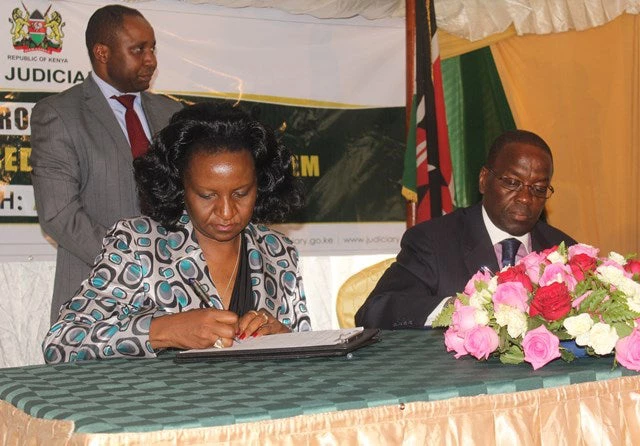
“You cannot solve a problem you haven’t fully understood.” – Chief Justice Mutunga, April 15, 2015
It’s difficult to know whether you’re succeeding in any institution – public or private – if you don’t set targets and collect data to measure progress against them. Courts are no different.
The Kenyan Judiciary has been making great strides in performance management. A ceremony at the Supreme Court in Nairobi last month was the latest step. Chief Justice Willy Mutunga signed “Performance Measurement and Monitoring Understandings” with the heads of Kenya’s courts.
These commit each court to targets such as hearing a case within 360 days, delivering judgments within 60 days of the end of a trial, and delivering a minimum number of 20 rulings a month.
Establishing these new targets was only possible because of four foundation stones the Judiciary put in place:
- Establishing a performance management committee, led by a senior judge.
- Creating a Directorate of Performance Management, with a dedicated complement of 20 staff with backgrounds in economics, statistics and business management.
- Conducting a 2013 comprehensive case census to establish the type and age of all cases, as well as the judges, support staff and other resources available in each court. The survey found – not surprisingly – that resources and caseload are not spread evenly across the courts. Magistrates with the highest case load have more than 100 times the number cases than those with the lowest.

This is where the Understandings represent such a heartening step – the data collected will populate the commitments made and allow judicial officers and management to clearly see, and be held to, their progress. With the Understandings in place, the Kenyan Judiciary now stacks up well against judiciaries in Europe. The European Commission’s Justice Scoreboard, which rates the performance management systems of 28 judiciaries, sets out four elements for building a performance infrastructure. With the developments above, Kenya now has all four in place and ranks above many countries in Europe.
The path to effective justice institutions is a long one and the Bank is pleased to walk with the Kenyan Judiciary on its journey. Some of the immediate next steps include:
- Embarking on an innovative impact evaluation to rigorously test different modes of communicating data to spur performance. This will utilize the data template and an annual court user survey, which the Judiciary is rolling out now. The user survey is one important way to ensure that the judges aren’t rushing to complete cases and in the process overlooking the quality of their interactions with citizens.
- Partnering with the Kenya National Bureau of Statistics to do a national justice survey. This will provide a picture of all the justice issues Kenyans face, where they take them for resolution (including why they often don’t come to the courts) and their satisfaction.


Join the Conversation